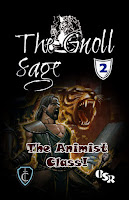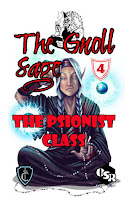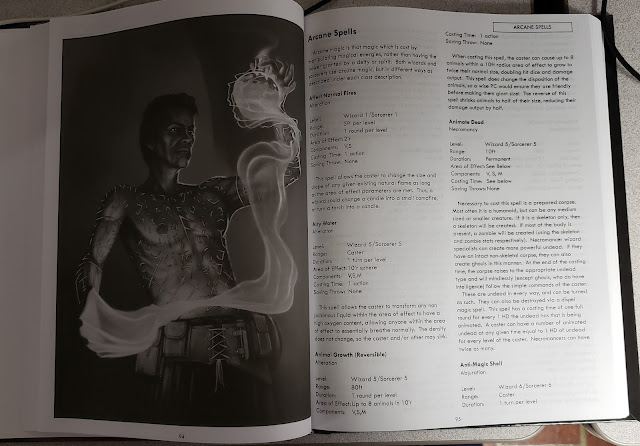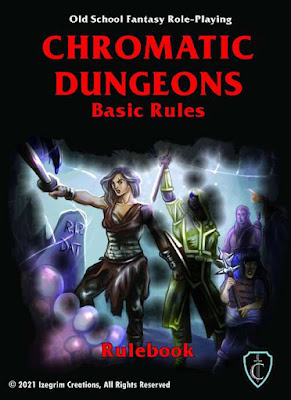Edited to add: Here are all the parts to this series: Part 1, Part 2, Part 3, and Part 4.
Heading into the last of my three-part series on Izegrim Creations' Chromatic Dungeons game. Today I want to review the first 5 issues of their Zine-like publication The Gnoll Sage. What it adds to Chromatic Dungeons and what you can get out of these even if you are not a Chromatic Dungeons player.
The Gnoll Sage
For this review, I am considering the PDFs from DriveThruRPG as well as the printed, digest-sized, soft-covers I received via Kickstarter.
Each book is 24 or so pages with Issue #5 coming in at 42 pages. Color covers and black and white interiors. Each one is released under the OGL so a couple of pages go to the license statement.
On the surface, there is a strong influence from Dragon magazine, but not in the way say Gygax magazine tried to do. The influence here is easily one of someone that had read and grown up on Dragon and wanted to recreate the feeling rather than the actual layout. It serves The Gnoll Sage (TGS) well.
The unifying thread through all these issues is the involvement of "Fleabag" the eponymous Gnoll Sage. Not Phoebe Waller-Bridge (but that would be hilarious) but an intelligent, erudite, be-spectacled, and maybe a bit of a pacifist, Gnoll who presents topics from the issue/zine from their point of view. I personally rather like it. It fits well into the idea that no humanoid race in Chromatic Dungeons has a default alignment. The funny part, for me at any rate, is I have often agreed with this idea on my blog EXCEPT for Gnolls. Maybe I'll give Fleabag a try anyway.
Each zine has a main feature, usually depicted on the cover, and other details like some magic items, equipment, spells, and so on. There is a comic section reminiscent of "Dragon Mirth" as well. There is an editorial in each issue talking about the issue and what might be coming next.
The material presented in each issue is overtly for the Chromatic Dungeons game, but it is all written in such a way, with extra notes when needed, that it can be used with just about any 80s or 90s versions of *D&D or any clone that emulates them. In particular, I felt they would be very handy to use with B/X D&D or Old-School Essentials.
The Gnoll Sage #1The first issue details the Mrav Covjecka, a group of insectoid/humanoid hybrids that need humanoid blood to nurse their brood. We get an "Ecology of" article as told to us by Fleabag. A monster statblock that can be used by any d20 based game including D&D 5.
There is also a brief adventure featuring the new monsters. There is the humor section, some new magic items, some NPCs you can meet, a section of new spells and upcoming topics in future books.
There is also the OGL statement at the end.
The Gnoll Sage #2
In this second issue we are given the Animist class which is designed to replace classes like "the Witch doctor" or Shaman or even "Spirit Guide." This is a good thing since the term Animist encapsulates all of these ideas. It is a divine spellcaster in Chromatic Dungeons terms, but can easily be ported over to any other D&D/Clone. It could also be tweaked and added to D&D 5 if you like. The class and all it's powers take up 18 of the zine's 28 pages. I have not played it yet but it looks pretty solid.
The remainder of the book is given over to humor, the look forward, and a copy of the OGL.
The Gnoll Sage #3
The third issue of The Gnoll Sage gives us the ecology of a monster introduced in the Chromatic Dungeons hardcover, the Mushropod. In the Ecology Of article, we get more details from our Gnoll on the Scene, Fleabag as they let us know what they have uncovered about the sentient mushrooms. Again the stat block reminds me of a 5e one, but everything here lends itself well to use of any 20th century D&D or clone.
There is a very brief adventure featuring these guys, some humor, three new magic items, some new NPCs, and a new spell. We end with the State of the Business note from Waibel where he mentions his Rise of Authur project. If you follow him at all online now (late Fall 2021) you have seen the characters he has been working on.
The Gnoll Sage #4
Now here is one I was quite excited for. This issue introduces us to the Psionist class for Chromatic Dungeons or any other clone. We start with some fluff with Fleabag and the aftermath of the Mushropod attack from the last issue. Fleabag describes a unique "spellcaster" they had met who what not a spellcaster at all. We then get into the class proper. Now I am very particular about my psychic and psionic using classes. Even to the point where I have a preferred term (it's "psychic" btw) and I need them to be very different than my spell-using classes. Also if their powers can be built up over time with disciplines, then all the better. This class satisfies two of those three. The class is flexible to use just about anywhere and easy to introduce. In fact, with the most minor of tweaks, a 5th Edition class can be found here. The psionist can choose one of three disciplines; Psychometabolism, Telekinesis, and Telepathy. There are powers with each one and they grow as the character levels up.
We also get an ersatz Mind Flayer in the Mind Eater and some comics. In the State of the Business, we learn this was the last issue of the original four set, with issue #5 coming as a stretch goal.
This issue is the last of the Kickstarter issues and also the largest so far at 42 pages. This issue covers the Ecology of the Orc and sets out to challenge our notions, or at least stereotypes of orcs. This is introduced in the starting fiction with Fleabag challenging the party to think about what sorts of orcs they might be dealing with. What follows is a very long Ecology Of and details of seven very different Orc clans.
In the Ecology Of we learn the basic structure of an orc clan including numbers, leadership, and organization. What follows are descriptions of seven example clans. They are, briefly: Small Clans are the various orc clans represented in pretty much all other RPGs. The Iron Shield Clan, a group of orcs more interested in making weapons, and selling them, than using them. Yellow Fang, a group of plains orcs that wear the skins of their enemies as clothing. Chaka Plains orcs are not pacifists per see, but understand the value of life and death and respect it. Meet them peacefully and you will be respected, meet them with violence and they will happily escort you to your next life. There are the sea-faring orc pirates and privateers of the Red Sails, but they only attack the wealthiest of ships. There are the imperialistic and arrogant orcs of the Baildan Daguulalt (Empire) that combine the best, and worst, characteristics of Imperialisy Britain and the Roman Empire. They are brilliant and utterly convinced of their own superiority, in fact they made the cover. Finally the orcs of the Silver Glacier might be the most dangerous of all these clans.
That is a lot! There are still a couple of magic items, some comics, new spells, and some hints about the next issue and a new class The Commander.
Each issue runs for $5.00 for the PDF and $6.00 for the print or print/PDF combination.
Their digest size makes me think they will fit in well with the newest versions of Old-School Essentials or Swords & Wizardry. So even if you don't play the Chromatic Dungeons game, these are still great resources.





























